Introduction
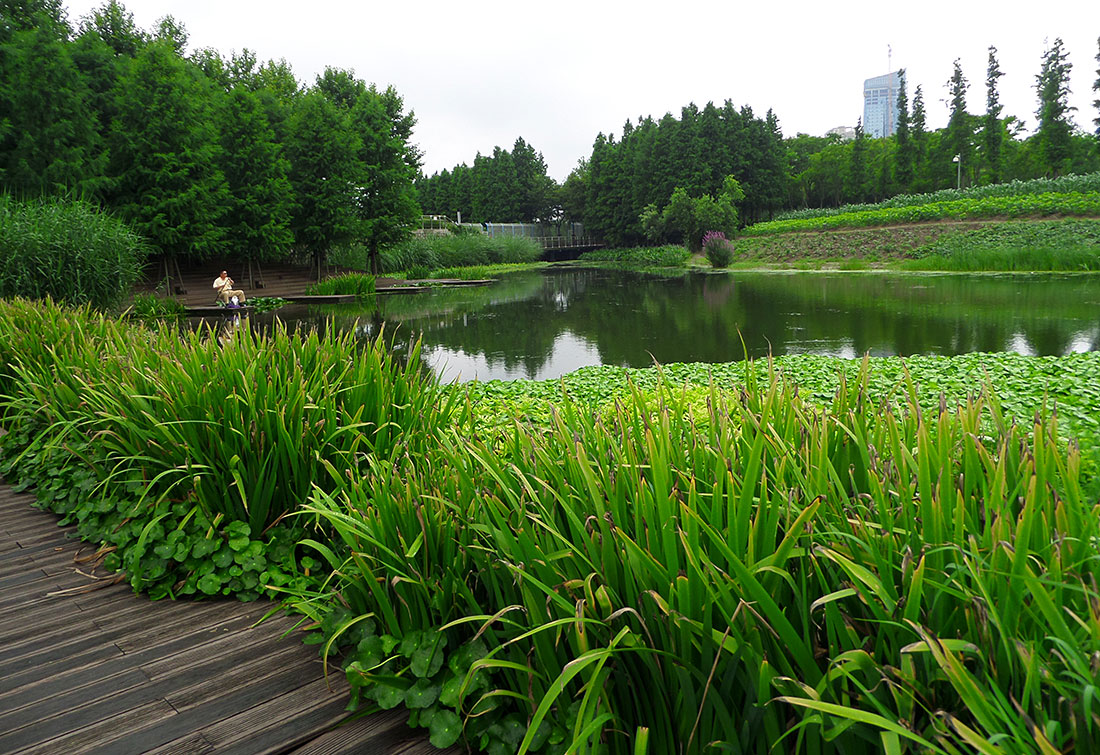
This constructed wetland provides all four of the ecosystem categories. Can you identify examples of each in this image of Houtan Park designed by Kongjian Yu. Photo: Austin: 2013.
Although this course is focused on landscape performance in relationship to water resources, it would be a mistake to think that these are not involved with many other issues of urban life. The Millennium Ecosystem Assessment divided ecosystem services that benefit humans into four classes, 1) Supporting, 2) Regulating, 3) Provisioning, and 4) Cultural (Hassan, 2005). In this unit you will learn that the water conservation, management and treatment process and technologies can be wrapped with additional features to secure benefits for people in each of these categories. The provision of treated water for a range of purposes is the clearest ecosystem benefit of biological wastewater treatment. Supporting ecosystem services indirectly benefit humans but are fundamental to the other three categories of services that are more directly enjoyed by people. Soil formation, nutrient cycling, habitat provision, water cycling, and primary production are all examples of supporting ecosystem services that constructed wetlands provide. We can augment the fundamental, or engineering aspects of the design of these facilities to enhance some or all of these services.
The systems that we have been working with provide regulating services. The flow of water and the availability (or reduction) of nutrients and gases is important at the local and global scale. The huge ecological dead zone in the Gulf of Mexico, beyond the mouth of the Mississippi River is the result of unregulated nitrate pollution from agriculture. As you know, constructed wetlands can be designed specifically to remove this excess nutrient.
Cultural Ecosystem Benefits
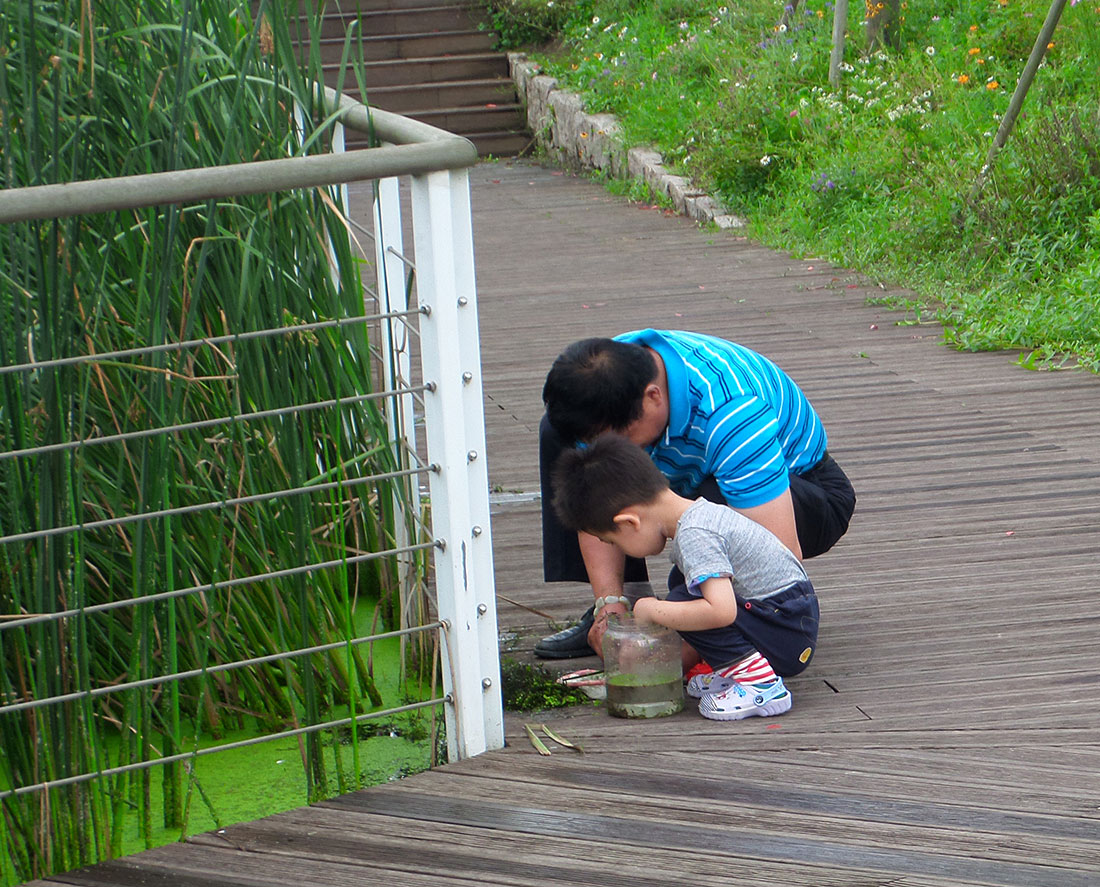
Holistic designs that provide multiple benefits are cost effective. This wetland treats polluted river water and provides citizens with educational opportunities, recreation and family gathering spaces. This is Houtan Park designed by Kongjian Yu. Photo: Austin: 2013.
Cultural ecosystem services are diverse and sometimes intangible. They include economic, aesthetic, education, and recreation benefits. Proximity to open space increases the value of property and can inspire economic development. Recreation has quality of life and health benefits. Stormwater or treatment wetlands as part of a green infrastructure that extends throughout a community and play an central role in the provision and character of recreational space. To meet their full potential these wetlands must be attractive contributions. They can be striking if designed to emphasize the color and texture of vegetation masses. Additional landscape beyond the wetland can provide a different habitat, design character and opportunities for paths and recreational spaces.
Wildlife and the Beauty of Nature
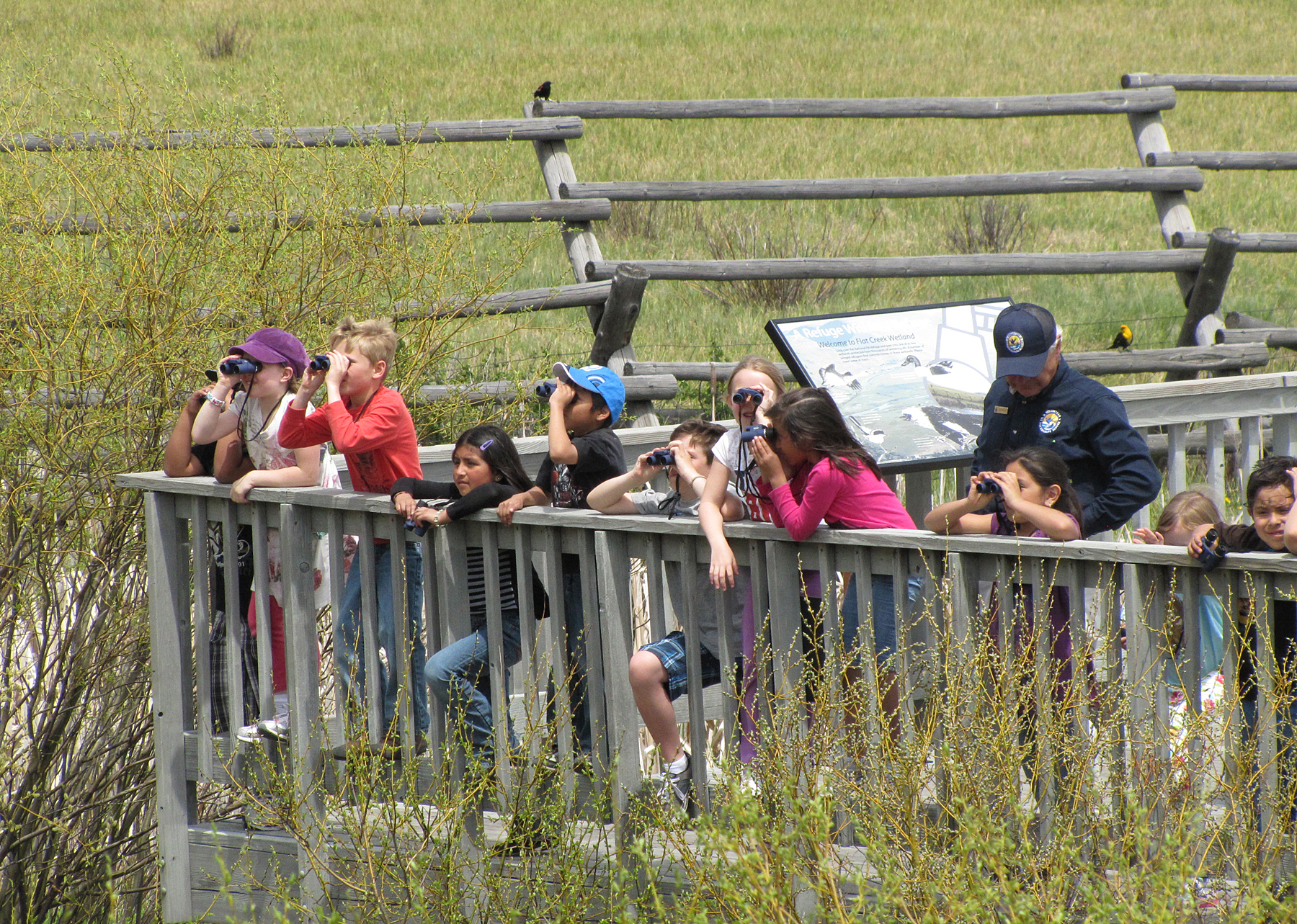
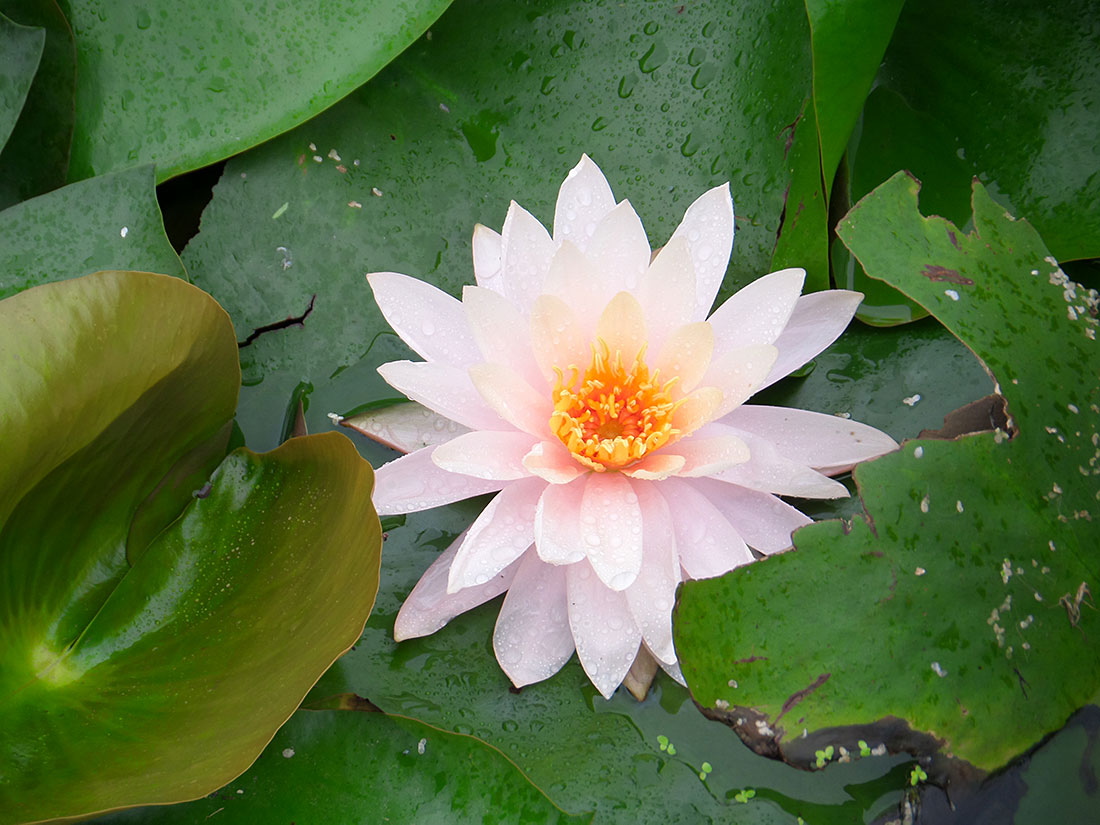
Left: Bird Watching. Photo: Lori Iverson USFWS, license Public Domain. Center: Water lily at Houtan Park. Photo: Austin, 2013.
Wildlife viewing is an incredibly popular activity that can be supported by the design of wetlands and their margins when augmented with user facilities, such as bird blinds.
Viewing and wildlife education are human activities but constructed wetland provide
Community Gathering
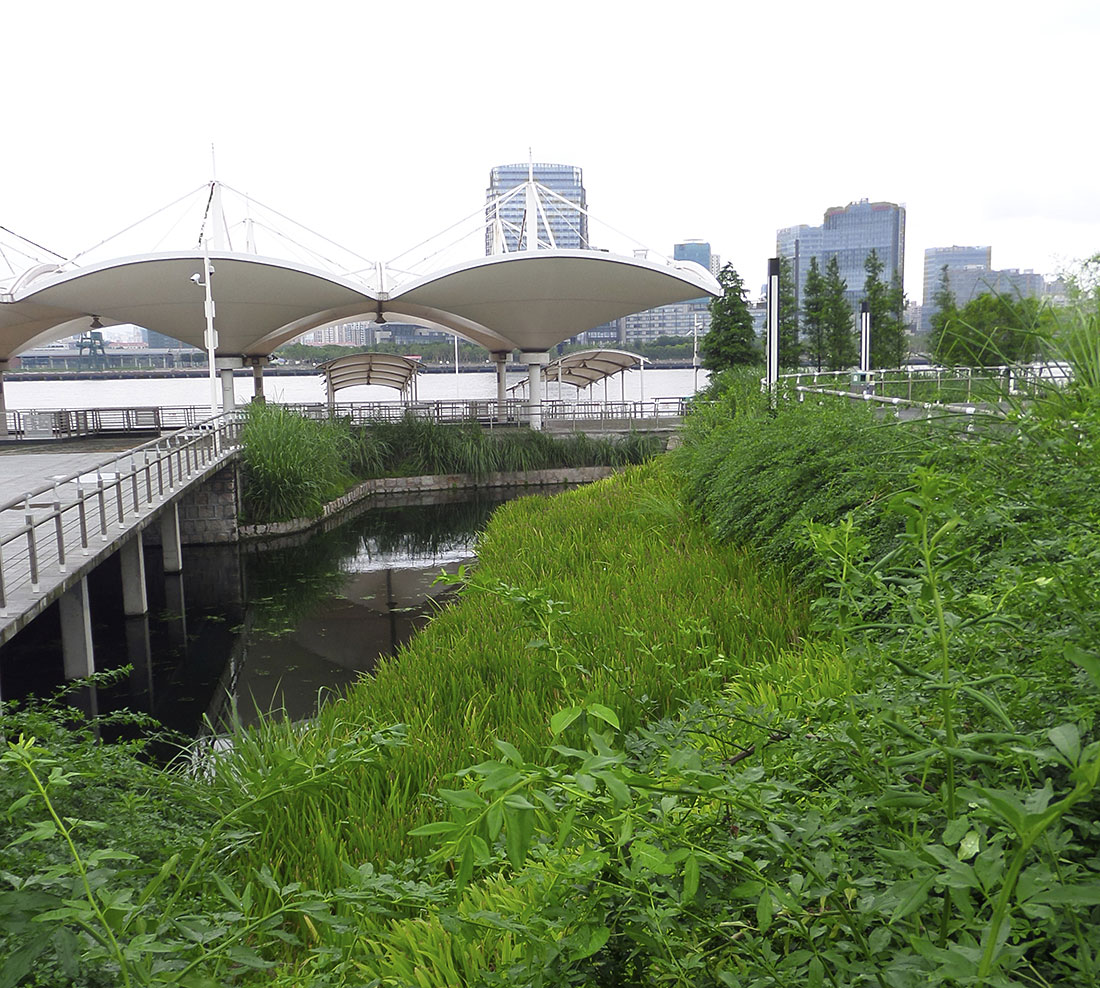
Houtan Park. Photo: Austin, 2013.
One of the program elements for the design for Houtan Park in Shanghai, China to receive visitors to the 2005 international exposition. They arrived via ferry and walked above the treatment wetlands on their way to the pavilion area.
Recreation
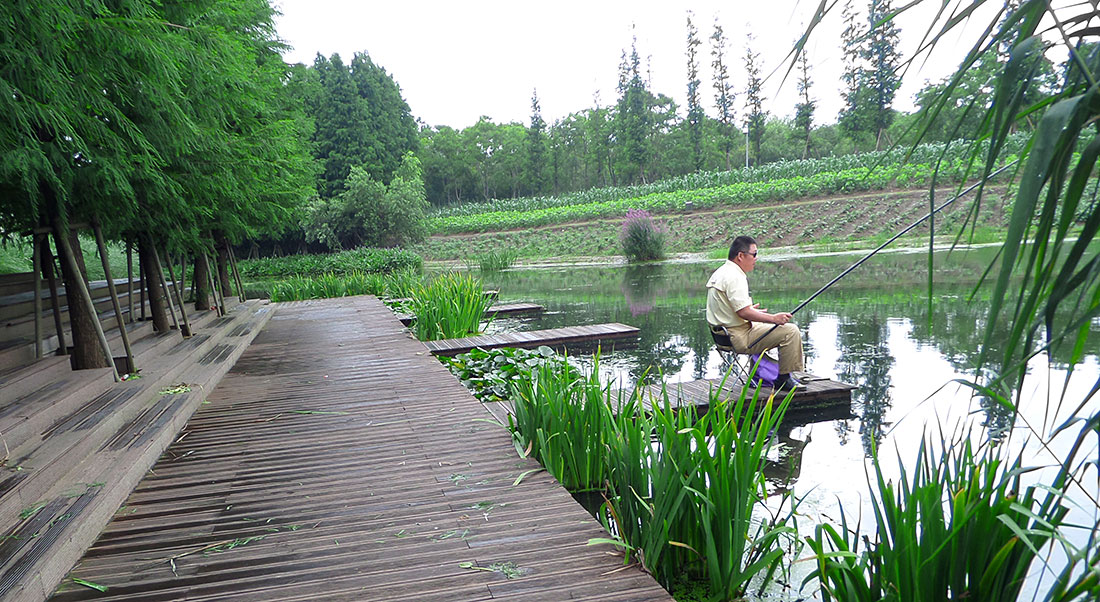
Houtan Park. Photo: Austin, 2013.
After the Shanghai exposition closed the citizens retained the benefits of the park including the public gathering areas, fishing docks, hillside agriculture and beauty that you can see in this image.
Sustainability and Public Art
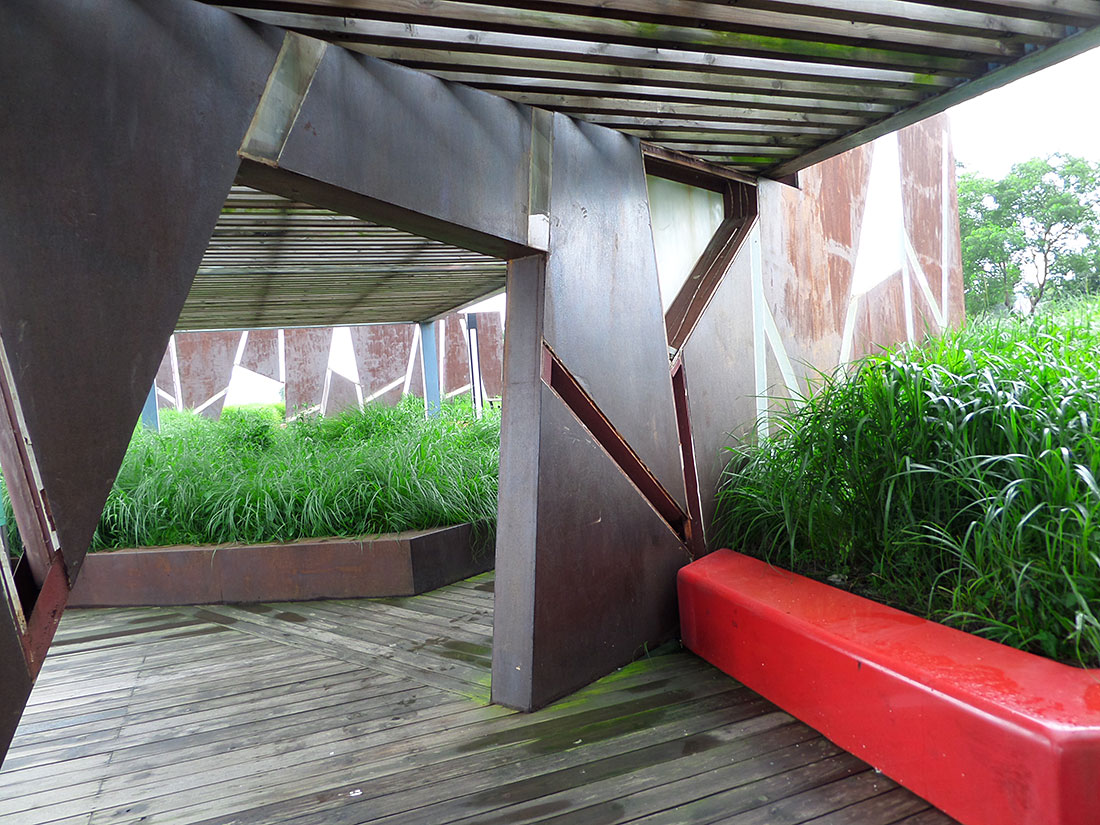
Houtan Park. Photo: Austin, 2013.
Houtan Park transformed a former steel plant brownfield site and utilized the abandoned industrial materials to create art and functional structures.
In summary, wetlands should always be designed to contribute ecosystems services in each of the categories enumerated above. This holistic approach makes economic and environmental sense.
Habitat
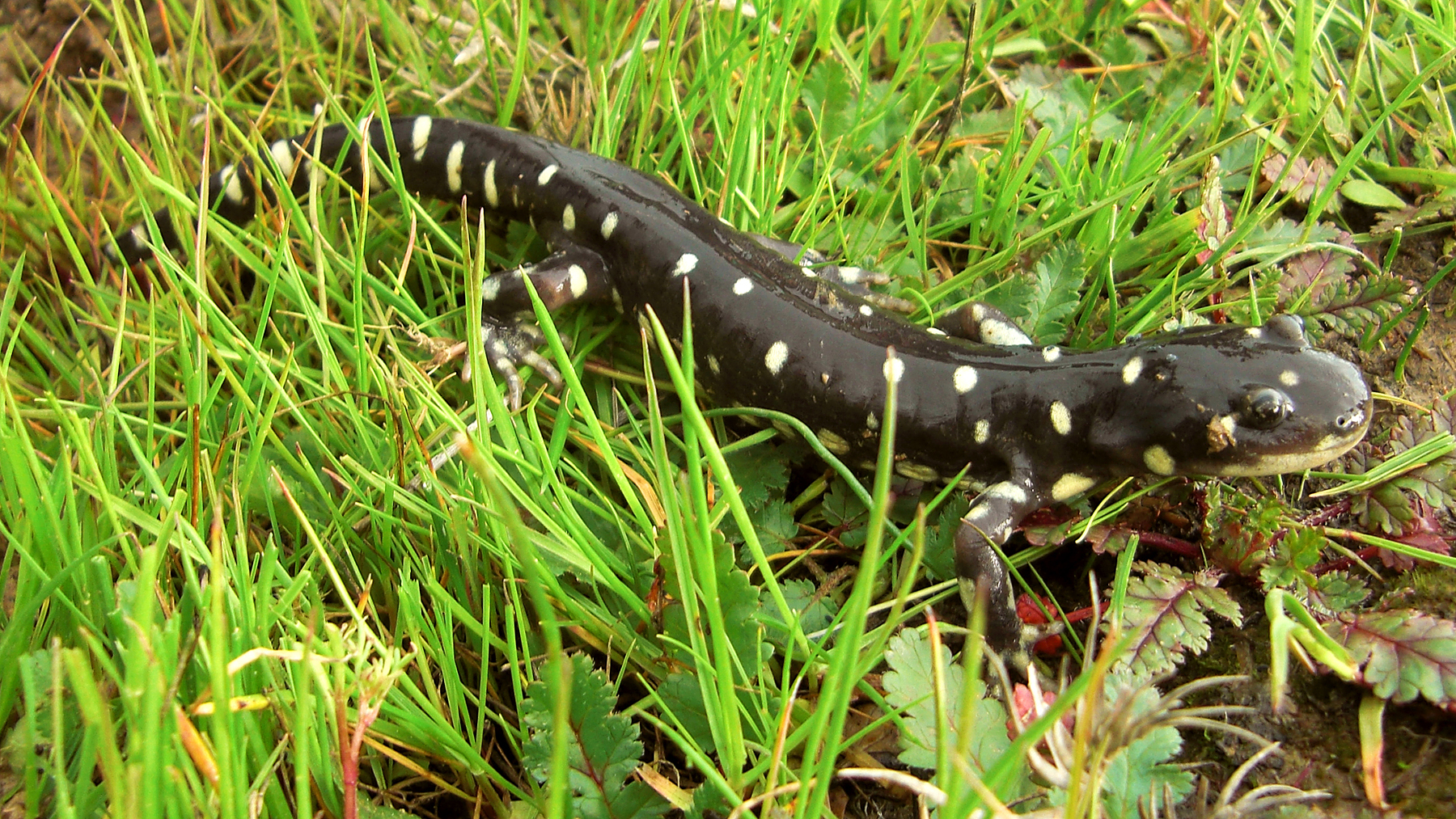
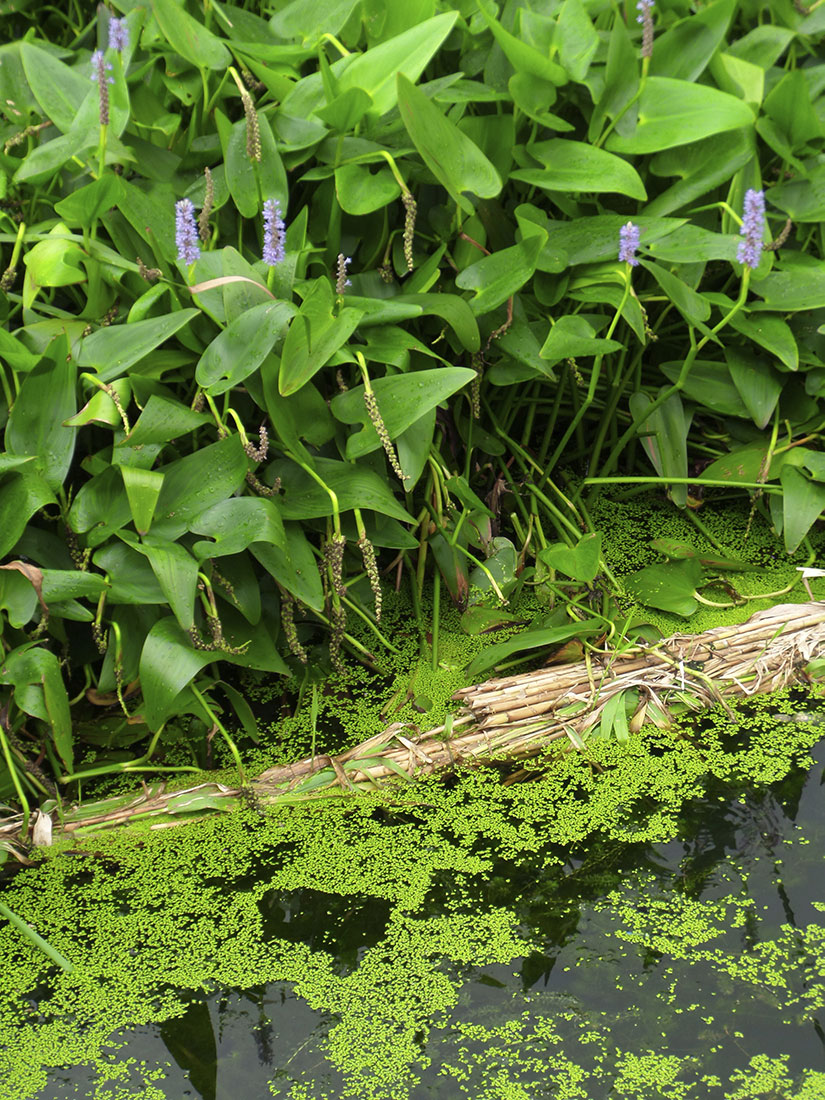
Left: Salamander. Photo: John Cleckler USFWS, license Public Domain. Right: Wetland vegetation. Photo: Austin, 2013
Viewing wildlife and nature education are human activities but constructed wetlands provide wildlife habitat as well. This is especially true in urban areas where wetlands were destroyed during urbanization. The various pond depths, vegetation types and the adjacent upland vegetation can be designed to foster birds, mammals, fish, amphibians and insects to create a heterogeneous landscape filled with habitat niches. For example, the abundance of blackbirds, coots, dabbling ducks and diving ducks is lower in wetlands containing continuous and dense stands of emergent vegetation and water depths from 0.3 m to 1 m. The variety of species in FWS wetlands increases when FWS wetlands are designed to include about half the area as open water and half covered with emergent vegetation (Fleming-Singer and Horne 2006). Similarly, a diverse planting palette supports more insect and animal species as a study of dragonflies demonstrated.
Hybrid Wetlands
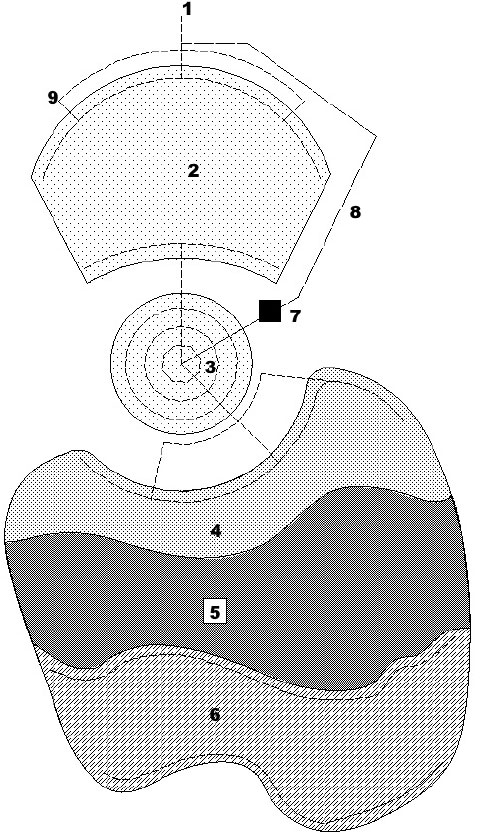
This plan for a hybrid wetland includes a HSSF, VSSF and FWS stages in sequence along with a recirculation step. Plan: Austin, 2011.
To maximize the stormwater peak and volume reduction, as well as the treatment effectiveness, a combination of wetland types and other measures, such as previous pavement, need to be planned. Similarly, a combination of wetland types is needed to treat the full range of contaminants present in domestic sewage and greywater. A vertical subsurface flow wetland might initiate a sequence to remove most of the BOD, TSS and pathogens from wastewater but either a HSSF or FWS wetland will be needed to complete treatment for the removal of additional pathogens and nitrate reduction.
A recent survey of 60 hybrid constructed wetlands revealed that they are primarily used in Europe and Asia. The most commonly used hybrid system is a VSSF followed by a HSSF stage. This pattern has been applied to the treatment of both sewage and industrial wastewaters. The use of a HSSF stage followed by a VSSF system has been reported only for treatment of municipal sewage. 38 of the 60 systems reviewed were designed to treat municipal sewage while 22 treated various industrial and agricultural wastewaters. The VSSF > HSSF pattern is slightly more efficient in ammonia removal than other hybrid combinations. All types of hybrid constructed wetlands are comparable with single VSSF wetlands in terms of ammonium removal rates. However, constructed wetlands with a FWS stage remove substantially more total nitrogen as compared to other types. All types of hybrid constructed wetlands are more efficient in total nitrogen removal than single HSSF or VSSF constructed wetlands (Vymazal, 2013).
Oaklands Park
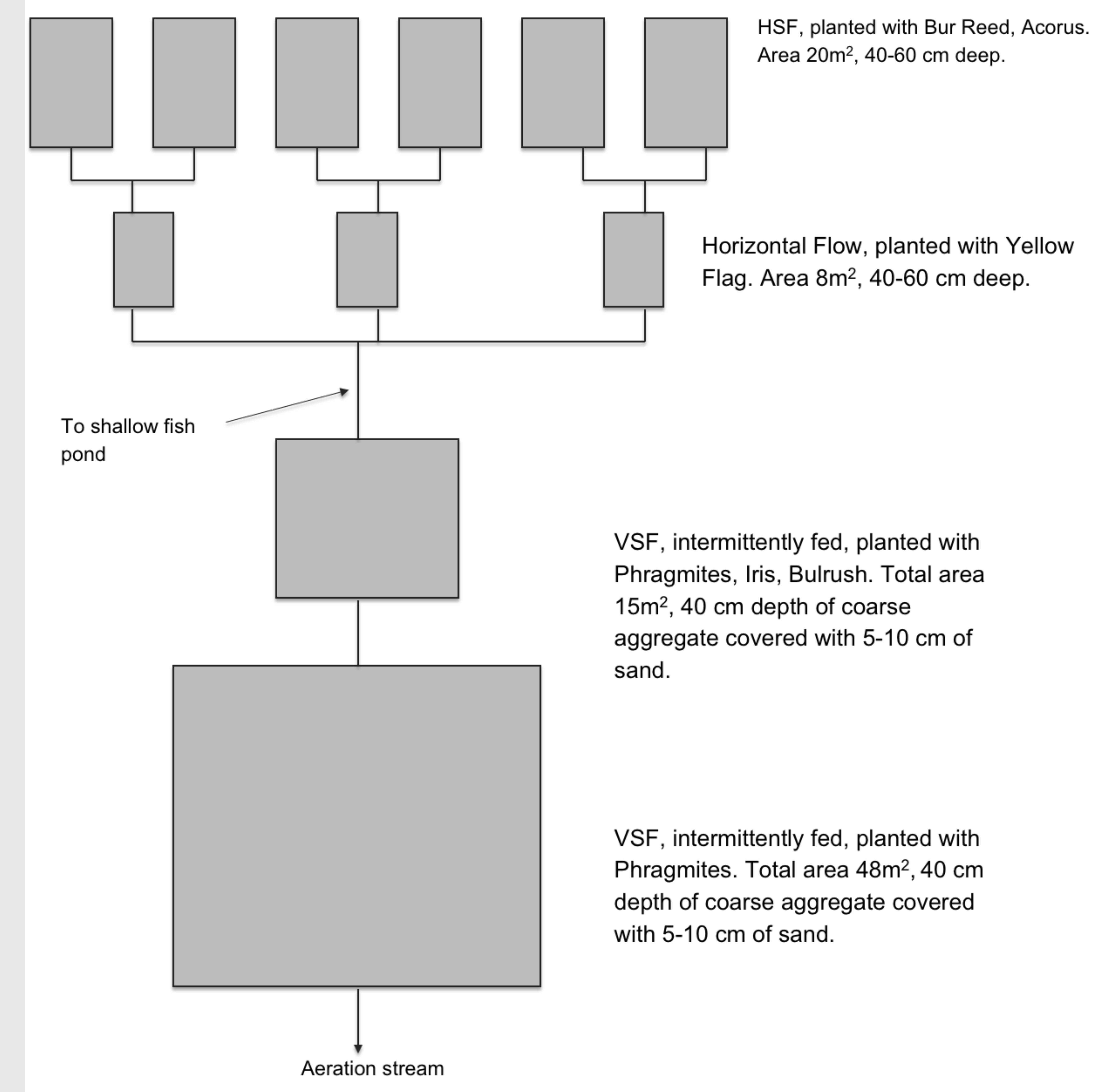
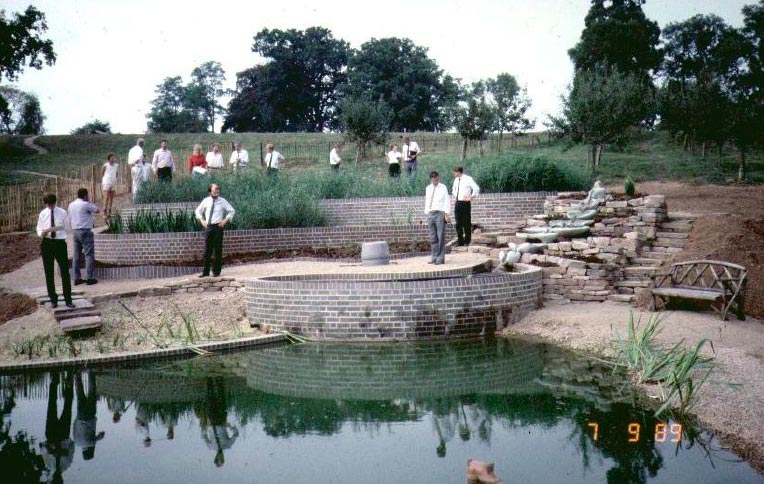
Left: Diagram of the treatment sequence at Oaklands Park. Image: Austin, 2011. Right: The terraced wetlands are shown in 1989 and from about the same viewpoint in 1999 in the image below. Photo: Paul Cooper, 2009.
A hybrid treatment wetland constructed at the Oaklands Park in the United Kingdom, exemplifies a hybrid system built to serve a population of 65 people. The treatment diagram above shows that pre-treated wastewater from septic tanks enters six VSSF wetland cells, only one of which is active at any time to avoid clogging the sand media in the cell. The VSSF cells are fed with wastewater intermittently. The VSSF systems discharge into two stages of HSSF wetlands. The system concludes with a fishpond for additional nutrient removal (Burka 1990; Gaboutloeloe et al. 2009).
Oaklands Park Performance
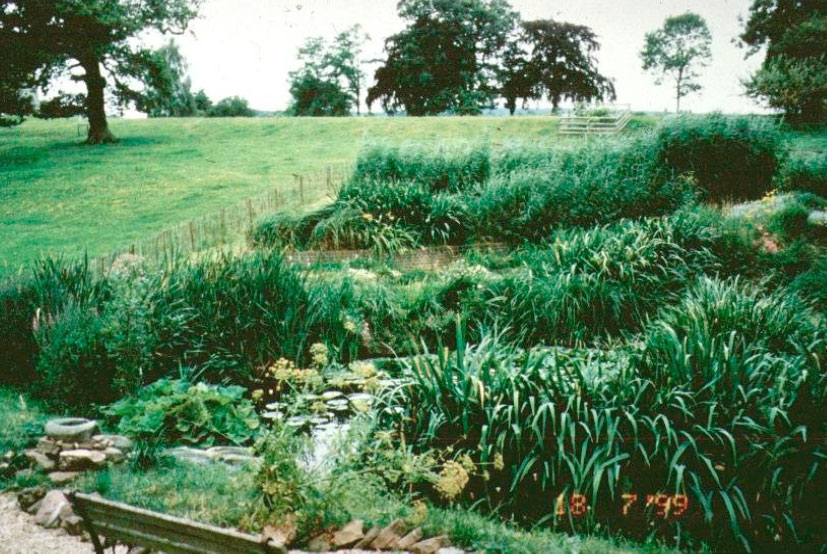
Left: The terraced wetlands at Oaklands Park in 1999. Photo: Paul Cooper, 2009.
The performance of the Oaklands Park wetlands sequence is shown below. The contaminant levels are shown for the inlet and outlet of each treatment stage. The values in red are the initial contaminant levels after pretreatment in a septic tank, while the bold black values show the levels after all of the subsurface wetland cells but before the water flows into the pond.
The data for pond effluent is not shown in the table below, but the free water stage further reduced ammonia, nitrate, and phosphorus levels. Phosphorus declined from 19.8 mg/L in the septic tank effluent to 8.2 mg/L (a 58.5 percent reduction) at the pond outlet. This level of removal is lower than the EPA target of 10 mg/L. The use of a calcium-rich gravel and sand in the subsurface wetlands would improve phosphorus removal (Vohla et al. 2011). Pathogenic bacteria was reduced to below the EPA standard for primary contact (Burka 1990; Gaboutloeloe et al. 2009). This is a significant achievement since no disinfection step, such as chlorination or ultraviolet light, was used.
Flow Form |
Surface area m2 |
Influent BOD |
Effluent BOD |
Influent TSS |
Effluent TSS |
Influent ammonium |
Effluent ammonium |
Influent nitrate |
Effluent nitrate |
Vertical |
8 |
285 |
57 |
213.3 |
38.5 |
50.5 |
29.2 |
1.7 |
10.2 |
Vertical |
5 |
57 |
14 |
38.5 |
17.7 |
29.2 |
14 |
10.2 |
22.5 |
Horizontal |
8 |
14 |
15 |
8 |
8.2 |
14 |
15.4 |
22.5 |
10 |
Horizontal |
28 |
15 |
7 |
9.2 |
4 |
15.4 |
11.1 |
10 |
7.2 |
|
|
|
a |
|
a |
|
b |
|
c |
a – EPA discharge requirement is less than 30 mg/L
b – No EPA discharge requirement for ammonia. In streams rainbow trout fry tolerate up to about 0.2 mg/L. Hybrid striped bass can handle 1.2 mg/l.
c - No EPA discharge requirement for nitrate. In streams concentrations above 5 mg/L inhibit growth in fish. Salmon are much more sensitive.
VSSF > HSSF Hybrid Wetlands
Left: Table reporting the performance of many hybrid wetlands with the VSSF > HSSF sequence of stages. of the treatment sequence at Oaklands Park. Source: Vymazal, 2013.
Hybrid treatment wetlands with the vertical subsurface stage first are the most common arrangement for constructed wetlands treating domestic sewage. The table above provides research data on the performance of these systems. The information in the table can be used to estimate the removal percentage for the various contaminants and as an expression of the landscape performance.
Contemporary Hybrid Wetland
Although it performed very well, the Oaklands Park project used design assumptions, such as the need to rest treatment cells, that are not valid for more contemporary environmental engineering. A recent demonstration project in the Czech Republic illustrates the benefit of hybrid wetlands using contemporary understanding of the biological and chemical processes. A three-stage wetland was constructed with a fully saturated VSSF cell followed by a freely draining VSSF cell. The third cell was a HSSF bed. Fifty percent of the effluent from stage two was pumped to stage one for denitrification. Average removal rates were: 94.5 percent for BOD (10 mg/L); 88.5 percent for TSS (9.2 mg/L); 78.3 percent for Ammonia (6.5 mg/L); and 65.4 percent for Phosphorus (1.8 mg/L). The concentration of nitrates in the outflow was 1.1 mg/L. The combined ammonia and nitrate removal was 73.5 percent.
The area of the wetland was 2 square meters per person. The two vertical flow cells comprised 40% of the total wetland area (Vymazal and Kröpfelová 2011). Higher water use in the United States might require slightly more total wetland area. Nevertheless, this area requirement is much less than the 5 square meters per person for a HSSF wetland treating domestic wastewater. This study shows the potential for advanced wastewater treatment, but needs the FWS stage to provide many of the secondary benefits possible.
In fact, if the removal of total nitrogen (rather than ammonia) is the primary treatment goal then a hybrid wetland that includes a FWS cell will produce better results than combinations of vertical and horizontal subsurface wetlands alone. However, any combination of vertical and horizontal subsurface stages will remove more total nitrogen than a single VSSF or HSSF wetland.
![]()
Enlarge the table above to review the performance of a number of hybrid wetlands that contain a FWS stage (Vymazal, 2013).
Study Questions
What are the four categories of ecosystem service articulated by the Millennium Ecosystem Assessment ?
List at least three cultural ecosystem benefits associated with free water surface wetlands.
The Oaklands Park hybrid wetland provides advanced treatment of domestic wastewater. Which standard did this system meet for concentration of pathogens?
The contemporary hybrid wetland demonstration project in the Czech Republic demonstrated an ammonia removal of ___________%.
The contemporary hybrid wetland demonstration project in the Czech Republic achieve a concentration of ___________ mg/L of nitrate in the effluent.
The contemporary hybrid wetland demonstration project in the Czech Republic required __________square meters per person served.
References
U. Burka, “A New Community Approach to Waste Treatment with Higher Water Plants,” in Constructed Wetlands in Water Pollution Control, Oxford: Pergamon Press, 1990.
P. Cooper, “What Can We Learn from Old Wetlands?,” Desalination, vol. 246, pp. 11–26, 2009.
M. S. Fleming-Singer and A. J. Horne, “Balancing wildlife needs and nitrate removal in constructed wetlands: The case of the Irvine Ranch Water District’s San Joaquin Wildlife Sanctuary,” Ecol. Eng., vol. 26, no. 2, pp. 147–166, Feb. 2006.
G. K. Gaboutloeloe, S. Chen, M. E. Barber, and C. O. Stöckle, “Combinations of Horizontal and Vertical Flow Constructed Wetlands to Improve Nitrogen Removal,” Water Air Soil Pollution Focus, vol. 9, no. 3–4, pp. 279–286, 2009.
R. M. Hassan, S. R. Carpenter, K. Chopra, D. Capistrano, and Millennium Ecosystem Assessment, Ecosystems and Human Well-Being. Washington: Island Press, 2005.
C. Vohla, M. Kõiv, H. J. Bavor, F. Chazarenc, and Ü. Mander, “Filter materials for phosphorus removal from wastewater in treatment wetlands—A review,” Ecol. Eng., vol. 37, no. 1, pp. 70–89, 2011.
J. Vymazal and L. Kröpfelová, “A three-stage experimental constructed wetland for treatment of domestic sewage: First 2 years of operation,” Ecol. Eng., vol. 37, no. 1, pp. 90–98, 2011.
J. Vymazal, “The use of hybrid constructed wetlands for wastewater treatment with special attention to nitrogen removal: A review of a recent development,” Water Res., vol. 47, no. 14, pp. 4795–4811, Sept. 2013.